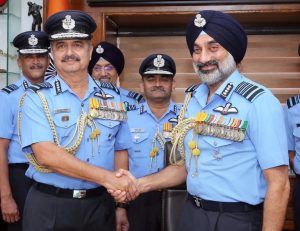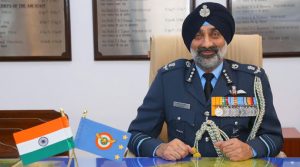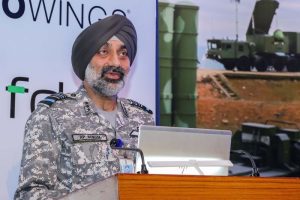DIGITAL NEWS GURU DELHI DESK:
Air Marshal AP Singh Appointed as New Chief of the Indian Air Force
In a significant development for India’s defense forces, Air Marshal AP Singh officially took over as the new Chief of Air Staff of the Indian Air Force (IAF) on September 30, 2024.
His appointment comes at a crucial time when the IAF is undergoing a period of modernization and strategic transformation to meet the evolving defense and security challenges of the 21st century. With a distinguished service record and extensive operational experience, Singh’s leadership is expected to bolster the Air Force’s readiness and global stature.
Background and Career Highlights

Air Marshal AP Singh has served the Indian Air Force for more than four decades, building an impressive track record in various operational, training, and leadership roles. Before assuming the position of Chief of Air Staff, Singh was the Vice Chief of Air Staff, responsible for overseeing various critical aspects of the force’s operations and strategy. During his tenure as Vice Chief, Singh demonstrated exceptional leadership in steering the IAF’s modernization efforts, which include acquiring cutting-edge aircraft and systems to maintain air superiority and bolster national security.
Commissioned into the IAF in 1983 as a fighter pilot, Singh has over 5,000 flying hours on various aircraft types, including MiG-21, MiG-29, and Sukhoi Su-30MKI fighter jets, along with transport and trainer aircraft. His operational experience spans numerous high-stakes assignments, including roles in combat, logistics, and defense planning. Notably, he has been involved in key military operations, including those during heightened border tensions and during the crucial Balakot air strikes of 2019, showcasing his tactical acumen and leadership skills.
Strategic Vision for the IAF

Air Marshal AP Singh takes the helm at a time when the IAF is not only focused on strengthening its air combat capabilities but also on expanding its reach to become a more expeditionary force. India’s geopolitical environment, especially in the context of rising tensions with neighboring countries like China and Pakistan, demands robust preparedness, and Singh’s vast operational expertise will be crucial in addressing these challenges.
Singh has always been a proponent of enhancing the IAF’s capabilities through technology and innovation. His tenure is expected to accelerate the modernization program that involves the induction of fifth-generation fighter jets, advanced unmanned aerial vehicles (UAVs), and upgraded radar and missile systems. Under Singh’s leadership, the IAF will likely continue to emphasize the development of indigenous technologies, in line with the Indian government’s “Make in India” initiative, which promotes self-reliance in defense manufacturing.
The IAF’s induction of cutting-edge systems, such as the Rafale fighter jets, S-400 missile defense systems, and the indigenous Tejas Light Combat Aircraft (LCA), marks a strategic shift towards reducing dependency on foreign arms suppliers. As Chief of Air Staff, Singh will have the task of ensuring these acquisitions are operationalized effectively and integrated seamlessly into the force structure. Moreover, the continued pursuit of future-ready air power, including space-based assets and cyber capabilities, is expected to be a hallmark of his tenure.
Addressing Security Challenges

Singh’s leadership is expected to be tested on various fronts, especially given India’s complex security dynamics. The northern and western borders remain tense, with occasional skirmishes and standoffs with both China and Pakistan. The role of the IAF in securing these borders, particularly in high-altitude regions like Ladakh, is critical. Moreover, the potential for airspace violations and the threat of drone warfare have added new layers of complexity to the IAF’s strategic objectives.
The IAF has increasingly been called upon to operate in multi-domain scenarios, where traditional air warfare merges with cyber, electronic, and space warfare. Singh’s tenure will likely focus on integrating these domains into the IAF’s combat strategy to provide India with a strategic edge. Given his operational background and experience in planning and execution, Singh is well-equipped to lead the IAF into this new era of warfare.
Human Resource Development and Training
While modernizing the hardware of the IAF is a priority, Singh is also expected to focus on the development of human capital within the force. In recent years, the IAF has made significant investments in the training and education of its personnel to keep pace with the technological advancements in aviation and defense. As the Chief of Air Staff, Singh will play a key role in enhancing training infrastructure and ensuring that aircrews and ground personnel are well-prepared to handle new-generation platforms.
Singh is also likely to emphasize leadership development within the force, preparing future commanders to take on larger responsibilities in an increasingly complex defense environment. His extensive experience as a pilot and in senior leadership roles positions him to lead efforts aimed at nurturing the next generation of officers who can navigate the challenges of modern air warfare.
Diplomatic and International Engagements
The IAF has become a key instrument of India’s defense diplomacy, participating in joint exercises and peacekeeping operations with air forces from around the world. Under Singh’s leadership, the IAF is expected to continue its active participation in international military exercises, such as the Malabar naval exercises and joint drills with countries like the United States, France, Japan, and Australia. These engagements are crucial not only for improving interoperability but also for projecting India’s growing military influence on the global stage.
Conclusion
As Air Marshal AP Singh takes charge as the Chief of Air Staff, the Indian Air Force is at a pivotal point in its history. With a focus on modernization, technological innovation, and strategic expansion, Singh’s leadership promises to guide the IAF through both opportunities and challenges in an evolving global defense landscape. His vast experience and deep understanding of both tactical and strategic operations will be invaluable as the IAF continues to assert its role as one of the world’s premier air forces.
YOU MAY ALSO READ: Mithun Chakraborty to Receive the Dadasaheb Phalke Award: A Celebration of His Cinematic Legacy








